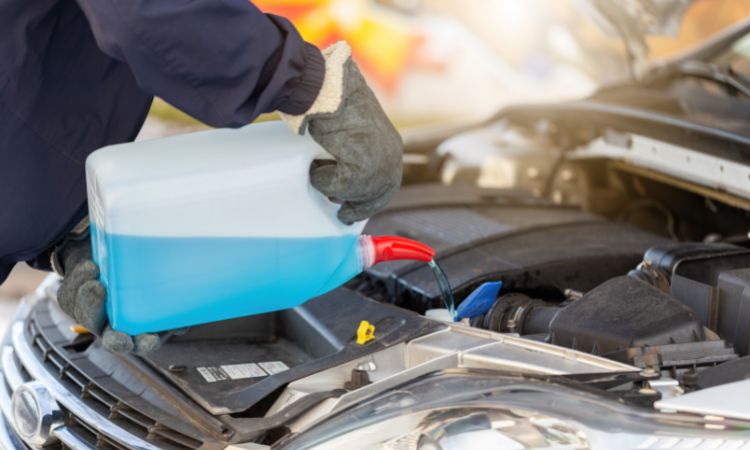How Do I Check the Hydraulic Fluid Level
The hydraulic fluid level in your car is important to maintain because it helps keep the brakes functioning properly. Checking the level is something you can do at home with a few simple tools.
If you want to check the hydraulic fluid level in your car, there are a few things you need to do. First, find the reservoir. It’s usually located near the engine, and it will have a dipstick attached to it.
Pull out the dipstick and wipe it off with a clean cloth. Then reinsert it into the reservoir and pull it out again. The level of fluid on the dipstick should be between the “full” and “low” marks.
If it’s below the “low” mark, you’ll need to add more fluid.

How to Check Hydraulic Oil Level on Excavator
Most excavators have a dipstick near the front of the machine to check the oil level. Park the excavator on level ground and shut off the engine. Pull out the dipstick and wipe it with a clean cloth or paper towel.
Reinsert the dipstick all the way and then pull it out again to check the oil level. The oil should be between the full and add marks on the dipstick. If it’s below the add mark, you’ll need to add hydraulic fluid.
How to Check Hydraulic Fluid in Case Tractor
If you’re like most farmers, you rely on your Case tractor to get the job done. That’s why it’s important to keep a close eye on your hydraulic fluid levels. Here’s how to check the hydraulic fluid in your Case tractor:
1. Park the tractor on level ground and set the parking brake.
2. Raise the hood and locate the hydraulic reservoir. It will typically be located near the back of the engine compartment.
3. Remove the fill cap from the reservoir and wipe away any dirt or debris that may be present.
4. Insert a clean dipstick into the reservoir and withdraw it again to check the fluid level. The fluid should be at or just below the “full” mark on the dipstick.
5. If necessary, add hydraulic fluid to bring the level up to where it should be. Use only approved hydraulic fluid for your particular model of tractor; consult your owner’s manual for specific recommendations.
Read: Fluid Solutions
How to Check Hydraulic Oil Level on Yanmar Excavator
If you have a Yanmar excavator, it’s important to check the hydraulic oil level regularly. Here’s how to do it: 1. Park the excavator on level ground and set the parking brake.
2. Remove the dipstick from the hydraulic oil tank and wipe it clean with a rag.
3. Insert the dipstick into the tank and remove it again to check the oil level. The oil should be at or near the “full” mark on the dipstick.
4. If necessary, add hydraulic oil to bring the level up to “full.” Use only approved hydraulic oil for your Yanmar excavator.
Do You Check Hydraulic Fluid With Tractor Running

If you’re like most tractor owners, you probably don’t give much thought to your machine’s hydraulic fluid until there’s a problem. But did you know that checking and changing your fluid regularly is one of the simplest and most effective ways to keep your tractor running smoothly? Here’s a quick guide to checking hydraulic fluid on your tractor:
First, make sure the engine is turned off and the parking brake is engaged. Then, locate the dipstick (it should be marked with an “H” for hydraulic fluid) and remove it. Wipe the dipstick clean with a rag and reinsert it into the reservoir.
Make sure it goes all the way in so you get an accurate reading. Now, pull the dipstick out again and check the level of fluid. It should be between the “full” and “add” marks on the dipstick.
If it’s low, add hydraulic fluid until it reaches the correct level. Be careful not to overfill – too much fluid can actually cause problems down the line. Finally, replace the dipstick and close up any access panels or covers.
You’re done! Now just remember to check your hydraulic fluid level every few months or so to keep your tractor running like a well-oiled machine.
Hydraulic Oil Level Gauge
If your machine has a hydraulic system, then it also has a hydraulic oil level gauge. This is an important component of the machine, as it allows you to check the level of hydraulic fluid in the system. The oil level gauge is usually located on the side of the machine, near the bottom.
To check the oil level, simply remove the cap from the gauge and look inside. You should see two marks on the glass: a full mark and a low mark. If the oil level is between these two marks, then it is at a good level and does not need to be topped off.
However, if the oil level is below the low mark, then you will need to add more hydraulic fluid to the system.
Adding hydraulic fluid is easy to do; just pour it into the reservoir until it reaches the full mark on the gauge. Once you’ve added enough fluid, replace the cap on the reservoir and start up your machine.
It should now be back to normal operation!

Credit: www.youtube.com
How Do I Know If My Hydraulic Fluid is Low?
If your hydraulic fluid is low, there are a few things you can do to check. First, check the fluid level in the reservoir. If it’s below the minimum line, then you need to add more fluid.
Second, look for leaks in the system. If you see any leaks, then you’ll need to repair them before adding more fluid. Finally, if your system is still not working properly after adding more fluid, then you may have a problem with your pump or valves and will need to have them checked by a professional.
Do You Check Hydraulic Fluid Warm Or Cold?
Assuming you are talking about checking the hydraulic fluid level in a system, it is best to check it when the system is cold. If the system is hot, the fluid will expand and give you a false reading.
Do You Check Hydraulic Fluid With Engine Running?
No, you should not check hydraulic fluid with the engine running. Hydraulic fluid is under pressure when the engine is running, and checking it while the engine is running could result in serious injury.
What Happens If Hydraulic Oil is Too Low?
If the hydraulic oil level is too low, it can cause problems with the operation of the equipment. The most common problem is that the equipment will not operate smoothly and may jerk or stall. This can be dangerous if the equipment is being used in a critical situation.
Checking the hydraulic fluid level
Conclusion
If you find that your car is not responding as quickly to the brake pedal as it used to, it might be time to check the hydraulic fluid level. Here’s a quick guide on how to do just that: 1. Park your car on a level surface and set the emergency brake.
2. Locate the reservoir tank under the hood. It will have a cover with “hydraulic fluid” or “brake fluid” written on it.
3. Remove the cover and wipe off any dirt or debris from around the opening with a clean cloth.
4. Check to see if the fluid level is at or above the “full” line on the side of the reservoir tank. If it is, then you’re all set! If not, then you’ll need to add some more fluid.

